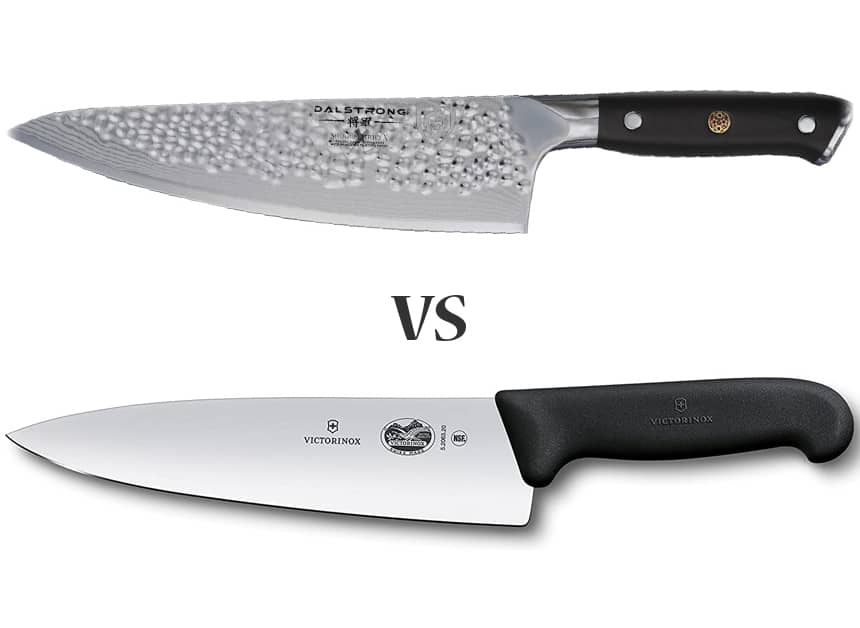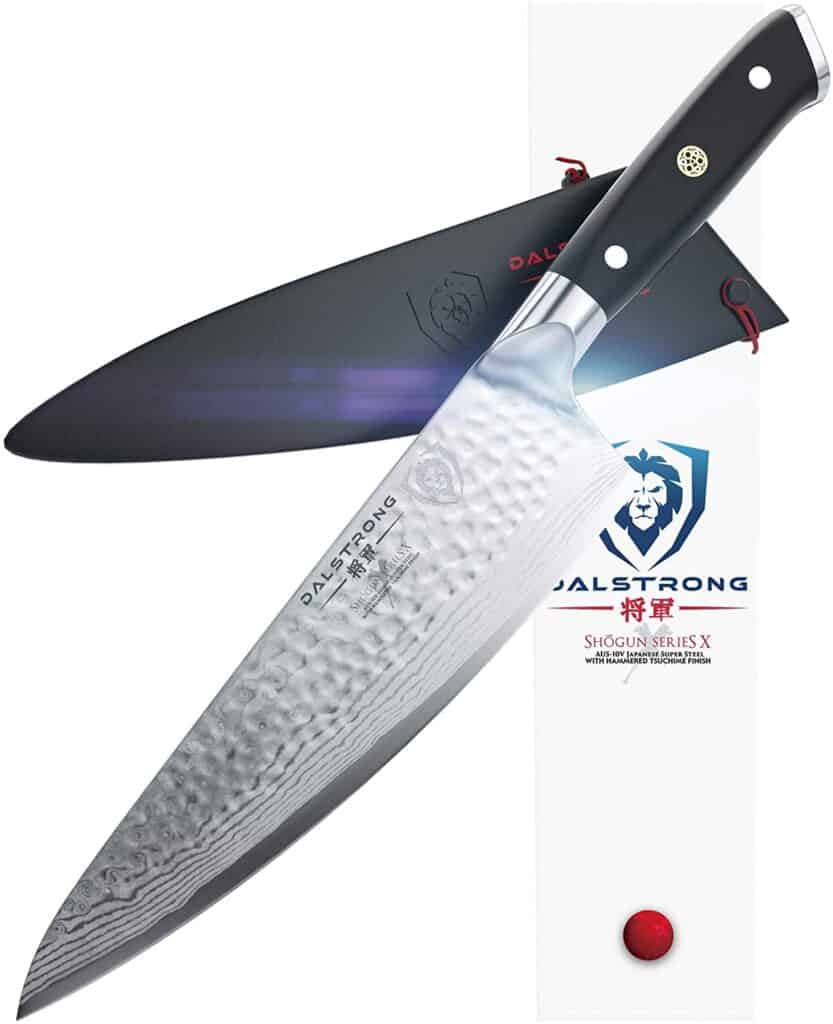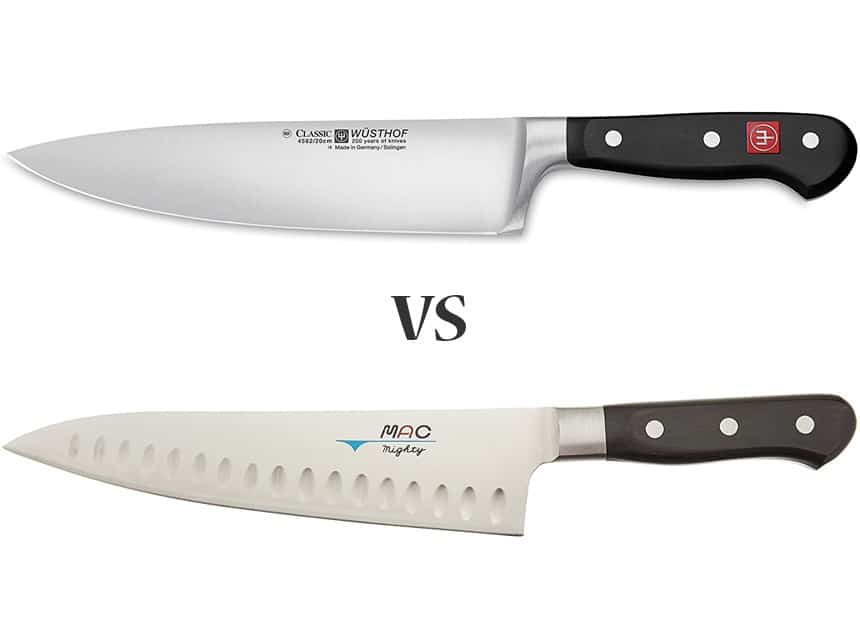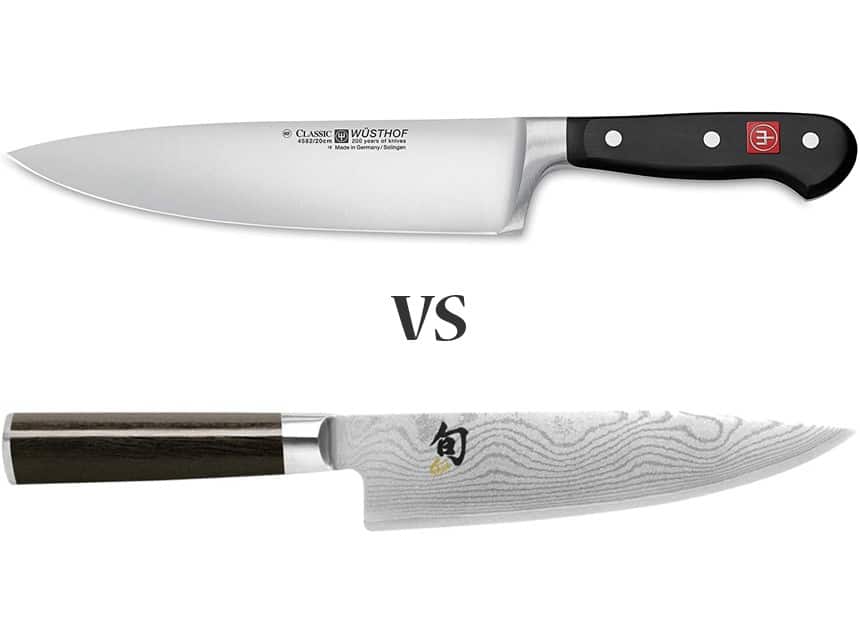
When it comes to cost-effective knives, Dalstrong and Victorinox do a fantastic job.
Dalstrong is a Chinese brand, offering knives using genuine Japanese and German materials but for a very low price.
Victorinox are European, focusing particularly on low-cost western-style knives.
In this article, I’m going to tell you the differences between these two brands. I’ll go in-depth into the details of each, talking about where they are made, what materials are used and the difference in price.
This should be all the information you need to select your perfect knife.
If your budget is over $100 and you’re looking for sharpness, the Dalstrong Shogun Series X is the best option. With a budget under $100 then Victorinox offers great value for money and a very durable knife.
| My recommendation | Current price |
| Dalstrong Shogun Series X Chef’s knife | View on Amazon (opens new tab) |
| Victorinox Rosewood Chef’s Knife 8-Inch | View on Amazon (opens new tab) |
Dalstrong vs Victorinox – Comparison Table
Here is my summary comparison table for each brand. This is mostly based on their main range of knives; the Dalstrong Shogun Series X and the Victorinox Fibrox Pro.
For a more in-depth look at each category then check out the rest of the article below.
| Category | Dalstrong | Victorinox |
| Country of Manufacture | China | Switzerland |
| Steel type | AUS-10V (other ranges use AUS-8 and X50CrMoV15) | X50CrMoV15 |
| Rockwell hardness | HRC 62 | HRC 56 |
| Factory edge | 12 degrees (double bevel) | 15 degrees (double bevel) |
| Handle material | G10 (fiberglass laminate) | TPE (thermoplastic) |
| Price range | $125 – $135 (Shogun Series X) | $50 – $60 (Fibrox Pro) |
| Main benefit | Lower price and sharper | Low price, comfortable design, durable |
| My recommendation | Shogun Series X (view on Amazon) | Victorinox Rosewood Chef’s Knife 8-Inch (View on Amazon) |
Dalstrong vs Victorinox – Where are they made
| Brand | Country of manufacture |
| Dalstrong | China |
| Victorinox | Switzerland |
Dalstrong manufactures it’s knives in Yangjiang, China.
On the face of it, the fact that Dalstrong knives are manufactured in China might be a little off-putting.
Let’s be honest, when we see the words ‘Made in China’ we usually think that the quality isn’t going to be great, but with Dalstrong I think there are some large benefits from having production based there.
They still use quality materials, but as the manufacturing costs are kept low these savings are passed onto the customer.
Dalstrong provides a range of both Japanese and German-influenced knives, in this article though I’m mainly focusing on their most popular Japanese style, the Shogun Series X.
Victorinox produces all their knives in Ibach, Switzerland.
Victorinox is a very interesting company as they are the original creators of the Swiss Army Knife, in fact, they produce around 45,000 Swiss Army Knives every single day.
The company was founded in 1884 and since then has expanded into other products such as chef’s knives and watches.
I think the practicality that you’d expect from a Swiss Army Knife is reflected in many of the features of Victorinox’s kitchen knives, which certainly focus more on durability than sharpness, but we’ll come to that next.
Dalstrong vs Victorinox – What steel do they use
Brands often use a variety of steel in their knives which changes between their ranges.
This is particularly true of Dalstrong. They use three different steels throughout their ranges as they have both German and Japanese influenced knives.
Their German series uses X50CrMoV15 (the same as Victorinox) and their Japanese series use both AUS-10V and AUS-8 depending on the range.
For a fair comparison, I’m going to focus on the most popular range for both Dalstrong and Victorinox knives.
For Dalstrong it’s their Shogun X series and for Victorinox it’s their Fibrox Pro range.
| Brand | Steel type | Rockwell hardness |
| Dalstrong Shogun Series X | AUS-10V | HRC 62 |
| Victorinox Fibrox Pro | X50CrMoV15 (stamped) | HRC 56 |
The Dalstrong Shogun Series X range uses Japanese steel AUS-10V. Other Dalstrong knives use X50CrMoV15 (for their German range) and AUS-8(another Japanese steel).
This is where we start to see the benefits of Dalstrong knives, the materials they use are very good quality, in this case, imported from Japan, but the Chinese manufacturing reduces the cost to the consumer.
AUS-10V is a Japanese steel with a great reputation. It’s a high carbon steel, with a Carbon content between 0.95% – 1.1%.
That means the steel is hard, allowing it to hold a sharper edge for longer.
The Chromium level is also high at 13% – 14.5%. It’s not as good as the Victorinox but it’s still enough to make AUS-10V a quality stainless steel and therefore very rust-resistant.
The trade-off here is sharpness for durability.
The Victorinox’s X50CrMoV15 steel is more durable than AUS-10V, the high Carbon Dalstrong knife can hold a sharper edge but it will be more brittle and thus more prone to chipping along the edge.
Victorinox knives use a German steel called X50CrMoV15.
It’s popular steel amongst producers of quality western-style knives. That’s because it has a particular focus on durability, whilst retaining enough strength for a sharp edge.
The main elements of interest within X50CrMoV15’s composition are Carbon, Vanadium and Chromium.
The Carbon content is 0.55%. That’s not particularly high when comparing it with other quality knives; however, it’s high enough to provide sufficient strength in the blade for a 15 – 20 degree angle on each side, which is standard for western knives.
The big benefit of not having a very high Carbon content is that higher Carbon steels are usually more brittle, therefore the 0.55% content keeps the blade durable.
That’s the same with the strong Vanadium of 0.4%, Vanadium improves the resistance to wear of the steel also adding to its durability.
The Chromium content is 15% is what the 15 in X50CrMoV15 represents. Chromium is vital for the durability of steel as it’s what makes stainless steel resistant to rust.
Steel need only be 10.5% to be considered stainless, so a 15% content is high and makes this a quality stainless steel, very unlikely to rust unless extremely mistreated by the owner.
Dalstrong vs Victorinox – How sharp are they
Once again I’m going to focus on the most popular knives from each brand for this comparison.
You will experience a far sharper edge with the Japanese-style Dalstrong knives. However, there is little difference between the Dalstrong’s lower-priced German range and Victorinox.
| Brand | Factory edge | Rockwell hardness |
| Dalstrong Shogun Series X | 12 degrees (double bevel) | HRC 62 |
| Victorinox Fibrox Pro | 15 degrees (double bevel) | HRC 56 |
When it comes to sharpness it’s often the angle of the blade that will be advertised, but actually, the hardness of the steel is probably more important.
Often people will look at the knife with the smallest angle and say that’s the sharpest, but in practicality, this isn’t quite true.
Harder knives will hold a sharper edge for longer. Often knives with a larger angle, but harder steel will actually perform better for sharpness than a softer steel with a more acute angle, as soft steel can’t retain an acute angle for long.
With that being said, Dalstrong offers the best of both worlds when it comes to sharpness.
The AUS-10V high Carbon steel has a Rockwell hardness of HRC 62, meaning it can retain a very sharp edge.
Combine that with the razor-sharp 12 degree out-of-the-factory angle on the blade and the Dalstrong is by far the sharper knife of the two.
Dalstrong uses Japanese steel and that tends to have a focus on hardness, in order to create a sharper edge.
Victorinox knives will dull much more quickly than Dalstrong knives and to maintain even the 15-degree factory angle they would have to be sharpened frequently, although that’s perfectly normal for western knives.
The benefit of using softer steel is that Victorinox knives will be much more durable. Since the Dalstrong uses a harder steel it will be more brittle.
Combine that with the very acute 12-degree angle and Dalstrong knives will be more prone to chipping along the edge if they are not looked after carefully.
Overall though, this is a clear win for Dalstrong and is probably its best feature.
Dalstrong vs Victorinox – What are the handles made from
The material used for handles is a vital and often overlooked feature of any knife.
A quality handle is often the sign of a quality overall knife. Handles need to be made from a durable material that can withstand all the heat and moisture fluctuations knives can experience in the kitchen.
Once again we’ll focus on the two main ranges from each brand, the Dalstrong Shogun Series X and Victorinox Fibrox Pro.
| Brand | Handle material |
| Dalstrong Shogun Series X | G10 (fiberglass laminate) |
| Victorinox Fibrox Pro | TPE (thermoplastic) |
Dalstrong uses a fiberglass laminate called G10 for their Executive Plus knife handles. Not all Dalstrong knives use G10 but all Dalstrong ranges do use good quality materials for their handles, such as Pakkawood.
G10 is a fiberglass laminate, making it a fantastic material for knife handles.
It has the perfect combination of being extremely lightweight and very tough. It will be able to withstand any of the standard pressure of a kitchen.
Dalstrong use a variety of materials for their handles, not just G10.
But they always use quality materials, such as the Pakkawood used for their Phantom Series, a quality wood/resin material commonly used as a material by traditional Japanese knife manufacturers.
So whichever range of Dalstrong knives you choose, you can be confident that the handle will be a quality, durable and comfortable one.
Victorinox Fibrox Pro a thermoplastic material for their knife handles called TPE.
It is worth mentioning that whilst Victorinox’s most popular range uses TPE; they also have a knife that uses a very attractive Rosewood timber, which is actually my personal Victorinox recommendation.
But as the TPE knives are by far Victorinox’s most popular, I’m focusing on that.
Thermoplastic materials like these are ideal for knife handles due to their extreme durability.
Being a thermoplastic means it’s extremely resistant to temperature and moisture changes.
It’s a fantastic material to use for knife handles, that will undergo all sorts of pressures and it makes sense to use this material for your main range, which is usually your more practical range.
TPE has more flex in it than other thermoplastic pics, as a result, the TPE handle Victorinox use isn’t quite as tough as materials like POM, but on the upside it does offer a good amount of grip due to the texture of the surface.
Dalstrong vs Victorinox – How much do they cost
Both these brands have wide ranges of knives all at differing price ranges.
To allow for a fairer comparison I’ve categorized three of their major ranges that represent their highest and lowest cost knives.
I’ve tried to compare similar knives, sticking to 8 Inch Chef’s knives or the closest equivalent.
In brackets next to the general price range you’ll see the name of the range.
These prices are rough estimates. Prices do change over time but this is intended as a rough guide.
| Brand range | Dalstrong | Victorinox |
| Premium | $150 – $160 (Omega Series) | Not Applicable |
| Standard | $125 – $135 (Shogun Series X) | $110 – $130 (Professional) |
| Value | $50 – $60 (Gladiator Series) | $50 – $60 (Fibrox Pro) |
Both Dalstrong and Victorinox clearly have quite similar price ranges for their knives.
Both price their German style knives in the lowest price range, a mid-range knife from either of these brands costs around $120.
The price is one of the strongest features for both these brands. In particular with Dalstrong , If you found a genuine Japanese knife consisting of the same materials Dalstrong use, they would easily be 30%-50% more expensive.
Both these brands represent very good value for money with almost the exact same price points; however, I think the mid-range Japanese style knives Dalstrong offer are fantastic value for money, and represent a better deal than the equally priced Victorinox Professional.
Dalstrong vs Victorinox – What is the difference
Now that we have looked at the design, materials, background and price of these brands we can fully understand the difference, and you should be able to make an informed decision on which knife is correct for you.
The main difference between Dalstrong and Victorinox knives is that Dalstrong’s Japanese influenced knives are far sharper than any Victorinox knives, Victorinox knives however will offer more durability due to their softer steel.
| Brand | Main benefit |
| Dalstrong | Low price, very sharp |
| Victorinox | Low price, comfortable design, durable |
Both these brands offer very competitively priced knives. However, I think the Japanese style knives you can get from Dalstrong at around $120 are extremely good value for money.
They will be far sharper than any knife Victorinox offers.
The counter-argument to that is that Victorinox’s softer steel will be more durable and less prone to chipping along the edge.
Dalstrong vs Victorinox – Which is better for you
This is down to what you want from your kitchen knives.
For someone looking for an extremely sharp blade with a budget over $100, the Dalstrong is the obvious choice. For anyone interested in a, Japanese-influenced knife, who will be able to care for the knife properly, I would recommend the Dalstrong Shogun Series X.
Caring for a Dalstrong is not exactly hard, all you need to do is store it individually, such as in a knife block, using a blade sheath, or on a magnetic strip.
Essentially, you want to avoid knocking the blade edge against other hard objects when you’re not using it.
In busy family kitchens, where knives are likely to be thrown into the kitchen sink, cutlery drawer, or dishwasher without a second thought, this can be difficult.
But you’re aware of how to look after the blade, and just ensure it is properly stored after use, then the Dalstrong will provide a superior cutting edge.
If you have a budget under $100 for a busy family kitchen, where multiple people might be using the knife or it’s a risk of being damaged or left soaking in water, then I would recommend the Victorinox.
It’s more durable than knives using Japanese steel and will require less care and attention, and it’s inexpensive, so even if someone did manage to damage the knife, it’s not the end of the world!
The blade is still plenty sharp enough for a western knife and if you just want a reliable knife for really good value then the Victorinox is the knife for you.
My Dalstrong Recommendation

View the Dalstrong Shogun Series X on Amazon (opens new tab)
My Dalstrong recommendation would be its most popular knife, the Shogun Series X Chef’s knife.
It’s a hammered Damascus finish using AUS-10V steel, incredible quality when compared with the price.
Since the steel is extremely hard this is a knife you will need to take care of. It has to be stored in a knife block or in a sheath to ensure the blade doesn’t get chipped, and it should be wiped clean and dry after every use.
But if you do that you’ll be rewarded with an incredibly sharp knife for a price that is pretty hard to beat.
My Victorinox Recommendation

View the 8-Inch Victorinox Rosewood Chef’s Knife on Amazon (opens new tab)
The Fibrox Pro, with its thermoplastic handle, might be the most popular Victorinox knife, but it’s not my personal recommendation.
For a similar price, you can get the Victorinox Rosewood Chef’s Knife. It uses the exact same steel but has a beautiful Rosewood handle instead of the thermoplastic.
Rosewood is hard, so it’s still plenty durable, and I think the style it gives the knife is really hard to match at this price range. It certainly looks like a knife that would be more expensive than it actually is.
The handle shape is a classic design, along with the curved blade edge it’s ideal for rock chopping and is a lightweight knife overall.
For a knife around the $50 mark, you’ll find it hard to find another knife as stylish and as high in quality as this one.

